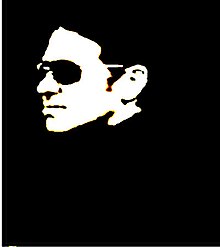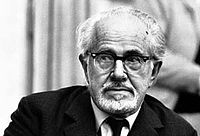Northwest School (art)
 | |
| Location | |
|---|---|
| Major figures | |
| Influences |
|
The Northwest School was an American art movement established in the Seattle area.[1][2] It flourished in the 1930s–40s.[3]
The Big Four
[edit]The movement's early participants, and its defining artists, have become known as "the big four": Guy Anderson, Kenneth Callahan, Morris Graves and Mark Tobey. Their work became recognized nationally from LIFE magazine's 1953 article Mystic Painters of the Northwest,[1] which featured biographies and works of the four artists. The article was the first such broad recognition of artists from this corner of the world beyond traditional Northwest Native American art forms, which had been long recognized as "northwest art."
These artists combined natural elements of the Puget Sound area with traditional Asian aesthetics to create a novel and distinct regional style, particularly in painting and sculpture, with some drawing, printmaking and photography. Tobey, Callahan, Graves and Anderson were all immersed in and greatly influenced by the atmosphere of the Pacific Northwest environment.[1]
Seattle was a common locale which they all shared at points in their lives, and some of them were closely associated for a time with the Seattle Art Museum in Volunteer Park. The town of Edmonds also figures heavily in the NW School, as Guy Anderson's hometown and studio were in Edmonds, and Morris Graves's home and studio were in nearby Woodway.[4] Over time, the influence of the natural setting of Western Washington, especially the flat lands, meandering river channels, and wide open skies of the Skagit Valley, became a unifying aspect of their art.[5][6] The media most commonly used by the painters in this group of artists were tempera, oil and gouache on canvas. They also used these media on paper and wood. Morris Graves worked for periods in three dimensional forms, using steel and glass and stone, among other materials. Guy Anderson, whose main medium was oil painting, also made works from bronze and had "collages" around his home of found objects from beach walks and deteriorating metal which he saw beauty in. These forms influenced his painting.
Style
[edit]The style of the Northwest School is characterized by the use of symbols of the nature of Western Washington, as well as the diffuse lighting characteristic of the Skagit Valley area.[6] The lighting and choice of earthy tonal ranges in the color is one of the most important qualities of Northwest art. Tobey, whose artwork did not include as much natural Northwest subject matter, is identified as Northwest style because of the soft pastel colors which he used, and the dark mist chroma of lighting, with few stark shadows.
The Northwest artists were labeled as mystics, although some forcefully denied this label. They denied being a "school" of art, but they did know one another. Callahan hosted salons in which the others participated. Anderson and Graves travelled together and painted in the North Cascades and elsewhere.
Dealers such as Zoe Dusanne, Gordon Woodside and John Braseth of the Woodside/Braseth Gallery, as well as museum professionals grouped the four artists together, as did journalists. Their styles showed unifying themes that suggested something unique and previously unseen from this geographic area. A review of the titles of some of the paintings leads to spiritual interpretations of northwest life.
In addition to the local natural setting and the Asian influence, the Northwest School also shows some influence from surrealism, cubism and abstract expressionism. The cubist influence is shown to some extent in Kenneth Callahan's Prism and the Dark Globe (1946) and Tobey's Western Town (1944). All these artists both loved the pacific northwest and were keenly aware of the larger world of which it was part. Their work was recognized for being both essentially northwest and far from provincial.
Influence
[edit]
Many younger artists around the Pacific Northwest found resonance in how qualities of the region seemed so strongly evident while something universal also glowed in these earlier artists' works. Influences and inspirations traceable to these earlier painters can be seen in work by many contemporary artists. One notable example would be Jay Steensma, who died in 1997. He left numerous moody, misty, "northwesty" paintings-some of them titled with admiring reference to Anderson, Tobey, Graves, and Helmi Juvonen. While Tobey influenced the Japanese artist, Kenjiro Nomura, the work of Nomura and Kamekichi Tokita was said to "foreshadow characteristics of the Northwest School".[7]
The works of artists such as photographer Mary Randlett and sculptor Tony Angell relate strongly to the Northwest School. Angell's sculpture often incorporates birds, as did Washington's, Gilkey's and McCracken's work. The flowing and silhouette style of Angell's work closely ties it to McCracken's sculpture. Randlett took black and white photographs of northwest landscapes that often have wonderfully painterly qualities.
The Museum of Northwest Art in La Conner, Washington is dedicated to the works of the original artists of the Northwest School and their successors.
Notable people
[edit]- Big Four
- Guy Anderson[6] (1906–1998)
- Kenneth Callahan (1905–1986)
- Morris Graves (1910–2001)
- Mark Tobey (1890–1976)


- Others
- Doris Totten Chase (1923–2008)
- William Cumming (1917–2010)
- Richard Gilkey (1925–1997) [8]
- Paul Horiuchi (1906–1999)[9]
- Clayton James (1918–2016)[10][11]
- William Ivey (1919–1992)[12]
- Helmi Juvonen (1903–1985)[13]
- Leo Kenney (1925–2001)[14]
- John Franklin Koenig (1924–2008)[15]
- Philip McCracken (1928–2021)
- Neil Meitzler (1930–2009)[16]
- Carl Morris (1911–1993)
- Hilda Grossman Morris (1911–1991)
- Ambrose McCarthy Patterson (1877–1966)[17]
- Mary Randlett (1924–2019)[18]
- Jay Steensma (1941–1994)[19]
- George Tsutakawa (1910–1997)
- Windsor Utley (1920–1989)[20]
- James W. Washington Jr. (1909–2000)[21]
- Wesley Wehr (1929–2004)[22]
References
[edit]- ^ a b c "Mystic Painters of the Northwest". Life. September 28, 1953. pp. 84–89. Retrieved February 9, 2022.
For more than a decade a remarkable art of shimmering lines and symbolic forms has been coming out of the northwest corner of the U.S., stirring up storms of irritation and enthusiasm in the galleries of New York, London and the Continent. Produced by a variety of artists living around Seattle, the paintings range in style from realistic to nonobjective. Yet they have one characteristic in common: they embody a mystical feeling toward life and the universe. This mystical approach stems partly from the artists' awareness of the overwhelming forces of nature which surround them, partly from the influence of the Orient whose cultures have seeped into the communities that line the U.S. Pacific Coast. The painters of Seattle have merged these influences, creating an art that without being a limited "regional art" is distinctive of the Northwest.
- ^ Cowles & Clark 1978, p. 9.
- ^ "LaConner – Thumbnail History". Essary 5655. Historylink.org.
- ^ Wehr 2000, pp. 9, 15, 84.
- ^ Laskin, David (March 12, 2006). "The Mystic Artists: A Puget Sound Quest". The New York Times.
- ^ a b c Tarzan, Deloris (July 11, 1982). "Skagit magic feeds the soul". The Seattle Times. p. E4.
Not until Guy Anderson became a La Conner resident did the artist feel that he hit his full stride as a painter
- ^ "Painting Seattle: Kamekichi Tokita and Kenjiro Nomura". Seattle Art Museum. Archived from the original on 10 October 2013. Retrieved 1 December 2013.
- ^ "Gilkey, Richard (1925–1997): Painter of Human Consciousness". Essay 5404. HistoryLink.org.
- ^ "Horiuchi, Paul (1906–1999): Master of Collage". Essay 3829. HistoryLink.org.
- ^ "James, Clayton (b.1918): Northwest Artist". Essay 5349. HistoryLink.org.
- ^ "Clayton James, noted Northwest artist, dies at 98". San Juan Islander. 17 October 2016.
- ^ Ament, Deloris Tarzan (May 20, 1992). "William Ivey, A Sensitive Mentor And Dean Of Northwest Painters". The Seattle Times. Retrieved 1 December 2013.
- ^ "Juvonen, Helmi (1903–1985): The Pearl of the North". Essay 3831. HistoryLink.org.
- ^ "Kenney, Leo (1925–2001): Painter of the Spirit of the Circle". Essay 5350. HistoryLink.org.
- ^ "John-Franklin Koenig". University of Washington. Retrieved 1 December 2013.
- ^ "Meitzler, Neil (1930–2009): Painter of Waterfalls". Essay 5327. HistoryLink.org.
- ^ "Ambrose Patterson". University of Washington. Retrieved 1 December 2013.
- ^ "Randlett, Mary (1924–2019): Landscape as Poetry". Essay 3844. HistoryLink.org.
- ^ "Jay Steensma". Archived from the original on 2007-11-23. Retrieved 2007-09-22.
- ^ "Windsor Utley papers, 1951–1959". Archives of American Art, Smithsonian Institution. Retrieved 1 December 2013.
- ^ "Washington, James Jr. (1911–2000): Art as Holy Land". Essay 5328. HistoryLink.org.
- ^ "Wesley C. Wehr paleobotanist and artist – composer/painter/poet". University of Washington. Retrieved 1 December 2013.
Bibliography
[edit]- Cowles, Charles; Clark, Sarah (1978). Northwest traditions: Seattle Art Museum, June 29 – December 10, 1978. Seattle Art Museum. ISBN 978-0-932216-00-7.
- Time (28 September 1953). LIFE. Time Inc. ISSN 0024-3019.
- Wehr, Wesley (1 January 2000). The Eighth Lively Art: Conversations with Painters, Poets, Musicians and the Wicked Witch of the West. University of Washington Press. ISBN 978-0-295-80257-2.
Further reading
[edit]- Ament, Deloris Tarzan, "Iridescent Light: The Emergence of Northwest Art", University of Washington Press, Seattle, 2001, ISBN 0-295-98147-4.
- Conkelton, Sheryl, and Landau, Laura, Northwest Mythologies: The Interactions of Mark Tobey, Morris Graves, Kenneth Callahan, and Guy Anderson, Tacoma Art Museum, Tacoma WA; University of Washington Press, Seattle and London 2003
External links
[edit]- Museum of Northwest Art
- Woodside Braseth Gallery http://www.woodsidebrasethgallery.com/


